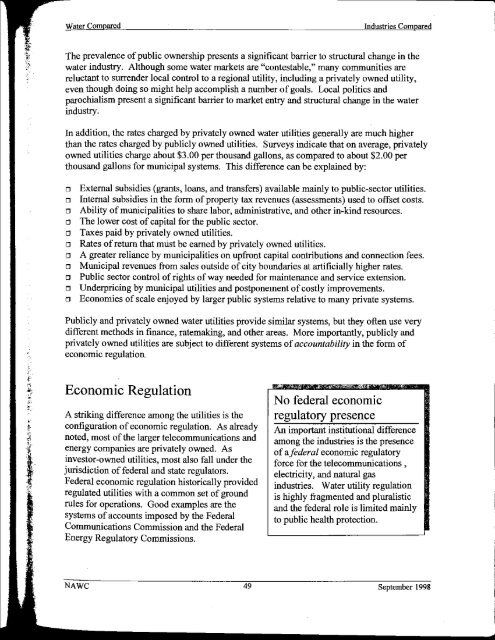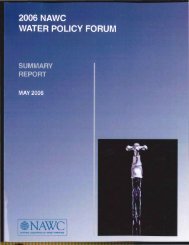BEECHER - NAWC
BEECHER - NAWC
BEECHER - NAWC
You also want an ePaper? Increase the reach of your titles
YUMPU automatically turns print PDFs into web optimized ePapers that Google loves.
Water ComparedIndustries ComparedThe prevalence of public ownership presents a significant barrier to structural change in thewater industry. Although some water markets are "contestable," many communities arereluctant to surrender local control to a regional utility, including a privately owned utility,even though doing so might help accomplish a number of goals. Local politics andparochialism present a significant barrier to market entry and structural change in the waterindustry.In addition, the rates charged by privately owned water utilities generally are much higherthan the rates charged by publicly owned utilities. Surveys indicate that on average, privatelyowned utilities charge about $3.00 per thousand gallons, as compared to about $2.00 perthousand gallons for municipal systems. This difference can be explained by:o External subsidies (grants, loans, and transfers) available mainly to public-sector utilities.o Internal subsidies in the form of property tax revenues (assessments) used to offset costs.o Ability of municipalities to share labor, administrative, and other in-kind resources.D The lower cost of capital for the public sector.o Taxes paid by privately owned utilities.o Rates of return that must be earned by privately owned utilities.D A greater reliance by municipalities on upfront capital contributions and connection fees.o Municipal revenues from sales outside of city boundaries at artificially higher rates.o Public sector control of rights of way needed for maintenance and service extension.o Underpricing by municipal utilities and postponement of costly improvements.o Economies of scale enjoyed by larger public systems relative to many private systems.Publicly and privately owned water utilities provide similar systems, but they often use verydifferent methods in finance, ratemaking, and other areas. More importantly, publicly andprivately owned utilities are subject to different systems of accountability in the form ofeconomic regulation.Economic RegulationA striking difference among the utilities is theconfiguration of economic regulation. As alreadynoted, most of the larger telecommunications andenergy companies are privately owned. Asinvestor-owned utilities, most also fall under thejurisdiction of federal and state regulators.Federal economic regulation historically providedregulated utilities with a common set of groundrules for operations. Good examples are thesystems of accounts imposed by the FederalCommunications Commission and the FederalEnergy Regulatory Commissions.No federal economicregulatory presenceAn important institutional differenceamong the industries is the presenceof a federal economic regulatoryforce for the telecommunications ,electricity, and natural gasindustries. Water utility regulationis highly fragmented and pluralisticand the federal role is limited mainlyto public health protection.49September 1998
















